|
A new breed of astronomers is scanning the
skies. Between them they have discovered over 70 planets beyond
our own Solar System, in orbit around other stars - and some of
them are quite astounding.
by Stuart Carter
Not too many years ago we only thought
there were 8 planets in our own Solar System. Then in 1930 a ninth
was discovered; but since then there has only been speculation about
a mysterious planet X. But the astronomers of past generations had
set their sights too low, or - to be more precise - too close.
Geoff Marcy (University of California
at Berkeley) and Paul Butler (Carnegie Institution of Washington)
started a much more ambitious search in 1987. They weren't interested
in just scanning our own back yard. They wanted to see if there
were any extrasolar planets orbiting distant stars. Their chosen
method of planet hunting was to look for the secondary tell-tale
effects of the planets.
Even with today's monster telescopes
such as the Keck Telescopes on Hawaii and the Very Large Telescope
in Chile, the possibility of directly seeing a planet is zero. They
are just too small and faint. Instead, Marcy and Butler had to be
content with the data they could measure from the parent star. They
examined the starlight and looked for tiny wavelength shifts, a
sure give away that a star was wobbling in response to a planet
in orbit around it.
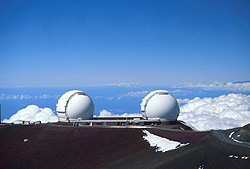
W M Keck Observatory
The first Keck
telescope has discovered tiny ice planets beyond Pluto
|
Any star with a planetary system should
wobble. Our own star wobbles by as much as half a million miles as
our largest planet Jupiter lumbers around it in a 12-year orbit. Marcy
and Butler were sure that if Jupiter could have this effect on the
Sun then a similar planet orbiting a distant world would produce a
similar wobble. For years they toiled night after night scanning the
heavens for a wobbling star. They found none. It was a depressing
time. Despite their strong convictions that all galaxies, including
our own Milky Way, should be teeming with planets they almost gave
up. Then, almost a decade after their hunt began, astounding news
arrived from overseas…
A young Swiss researcher had been studying
the star 51 Pegasi for his PhD. Didier Queloz had no preconceptions
about the orbits of extrasolar planets, and he was soon delighted
to find that he had recorded a dramatic wobble. But it was nothing
like the motion that Marcy and Butler had been looking for. They
had expected to see a wobble that would takes years, maybe as much
as the 12 year wobble of the Sun as Jupiter orbits it. What Queloz
found was entirely different - he observed on a much shorter time
scale and found a high frequency wobble. At first he thought it
was a mistake, but after he checked his data he realised that he
had found a planet the size of Jupiter racing around 51 Pegasi in
just 4 days!
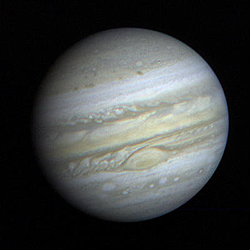
Jupiter is
1300 times the size of Earth
|
The world of astronomy was stunned.
As they began to confirm his observations the implications of the
discovery began to sink in; the planet must be very close to the
star and it must be very, very hot. Since the 51 Pegasi discovery,
Marcy and Butler have gone on to find many more of these 'hot Jupiters',
all in tight fast orbits.
Around the star, Tau Boötis is
the hottest planet every found - its surface temperature is more
than 1200 degrees Celsius. Orbiting around the star HD 195019 is
a planet 1100 times the size of the Earth but 8 times closer! And
the planet that goes around HD 187123 races around in just 3 days.
The astronomers were both excited
and disappointed. They had proved that there must be many planets
across the Cosmos, but nowhere that could be thought of as the slightest
bit hospitable or desirable. These 'hot Jupiters' would have annihilated
any Earth like planets. The theory of planet formation says these
big giants must have been born much further out. As they migrated
in towards the parent stars, they would 'bulldoze' any 'Earths'
in front of them, and push the smaller planets into the fiery star.
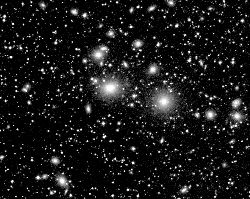
NASA
The Perseus
Cluster of Galaxies -
The Universe is accelerating away from us and is growing a
billion miles in every direction
|
The astronomers knew that if they were
to stand any chance of finding a planet like our own, then they would
have to find an entire suite of planets. Their wobble technique is
far too crude to directly detect the presence of an Earth-sized planet.
But they realised that if they could find a number of gas giants orbiting
at a safe distance from their parent star then there could theoretically
at least be a place where a small Earth-like planet could survive.
Debra Fischer, a colleague of Marcy
and Butler, has in recent years been one of the leading names in
the planet-hunting pack. She uses the Lick Observatory in California
to collect her raw data. In 1998 she announced her discovery of
a three-planet system orbiting the star Upsilon Andromedae. The
wobble she detected had baffled her for months; it was complex and
irregular and certainly wasn't the result of a single planet. In
fact, what she had discovered were 3 gas giants, one in a tight
circular orbit and two in wild eccentric orbits shooting past their
host star before slinging out into the icy depths of deep space.
It was a start - but this celestial
pinball machine was still far too violent for an Earth-like planet
to stand any chance of surviving. Fischer knew that what she needed
was a multiple planet system where the orbits are circular and where,
like our own Solar System, the gas giants keep their distance. After
years of painstaking research Fischer struck gold in 2001. She found
two large planets in circular orbits around the star 47 Ursae Majoris.
Their positions and sizes are similar to our own Jupiter and Saturn.
Between these gas giants and the host star is a large gap, possibly
a place where small rocky Earth-like planets could also be hiding.
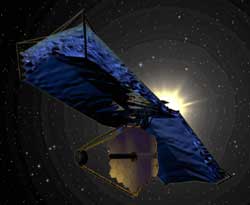
NASA
Artist’s
impression of the Next Generation Space Telescope: its exposed
mirror is three times the size of Hubble’s.
|
But will the astronomers ever be able
to 'see' a planet as small as Earth? A number of new projects make
it highly probable that in the next few years just such a discovery
will be made. The biggest and best is the billion-dollar Kepler telescope
scheduled for launch in 2005. This high-tech eye in the sky will monitor
thousands of stars simultaneously from the unobstructed view of space.
But Kepler won't watch for wobbles. It will scan for any brief dip
in light when planets pass in front of their parent stars. During
its three year vigil, Kepler should be able to pick out even the tiniest
star blink - indicating that a star has a planet as small as Earth.
The planet hunters are confident of
success. Watch this space.
Damon Wright is a Staff Writer for FirstScience.com. Copyright
(c) FirstScience.com
Click
here to read the follow up article to this one. Called 'Distant
Wanderers' - An article extract by Bruce Dorminey from his book
of the same name.
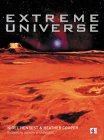 For
more information about the Universe in all its bizarre majesty take
a look at the new book released in October 2001 by Nigel Henbest
and Heather Couper - 'Extreme Universe'. The accompaniment to a
major three part series 'Edge of the Universe' which
is showing on Channel 4 in the UK in January 2002. The first part
aired on Monday 7th Jan 2002, and the next two - Killers in
Space and Final Frontier will air on Monday
14th and Monday 21st Jan respectively at 9pm. (See the 'Coming Soon'
section of www.pioneertv.com
for futher details) For
more information about the Universe in all its bizarre majesty take
a look at the new book released in October 2001 by Nigel Henbest
and Heather Couper - 'Extreme Universe'. The accompaniment to a
major three part series 'Edge of the Universe' which
is showing on Channel 4 in the UK in January 2002. The first part
aired on Monday 7th Jan 2002, and the next two - Killers in
Space and Final Frontier will air on Monday
14th and Monday 21st Jan respectively at 9pm. (See the 'Coming Soon'
section of www.pioneertv.com
for futher details)
This lavishly illustrated book explores
the mysteries of the planets, the birth of the universe and other
strange, but true, phenomena of space and time.
See further details at Amazon.co.uk
|
